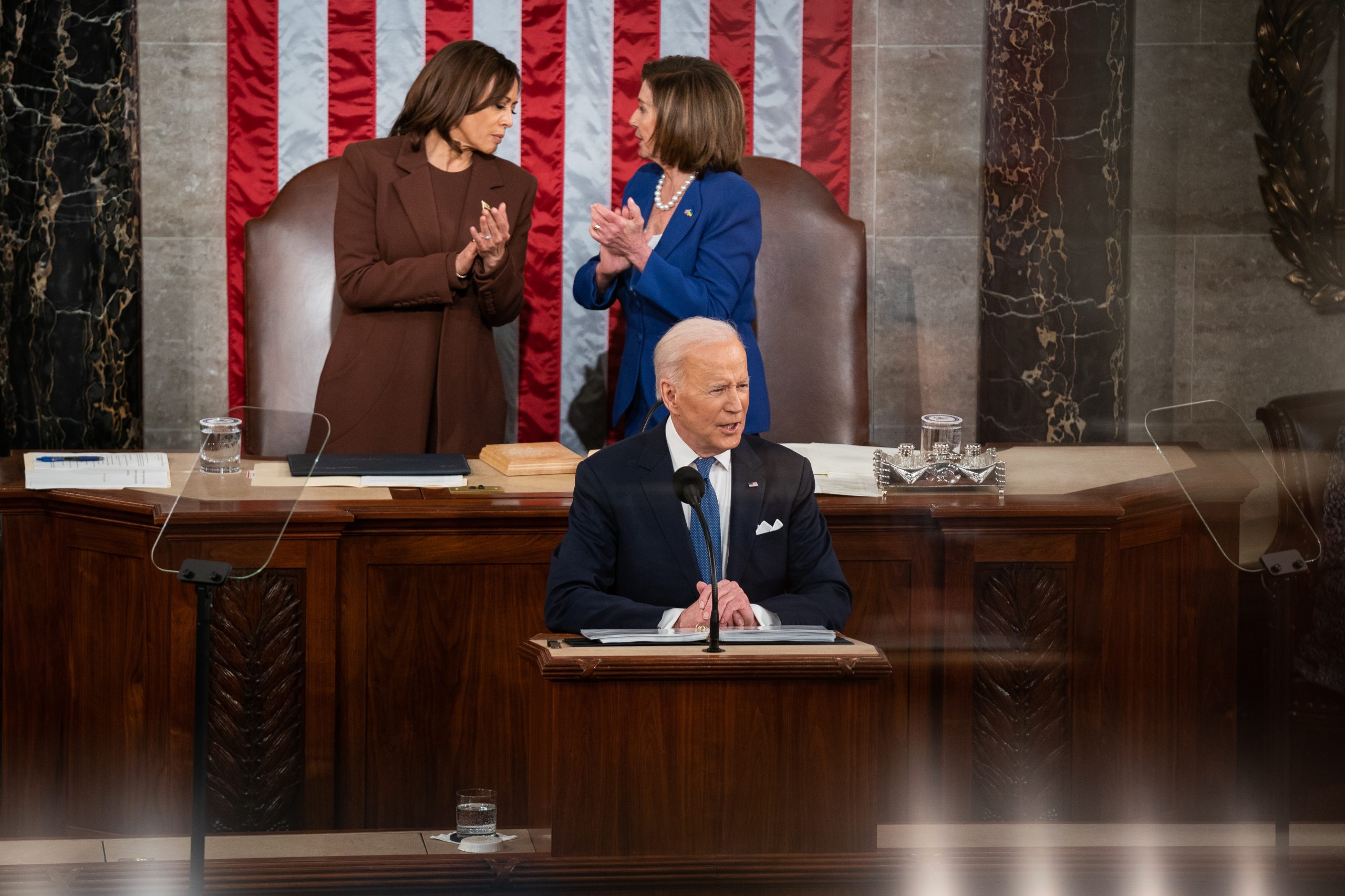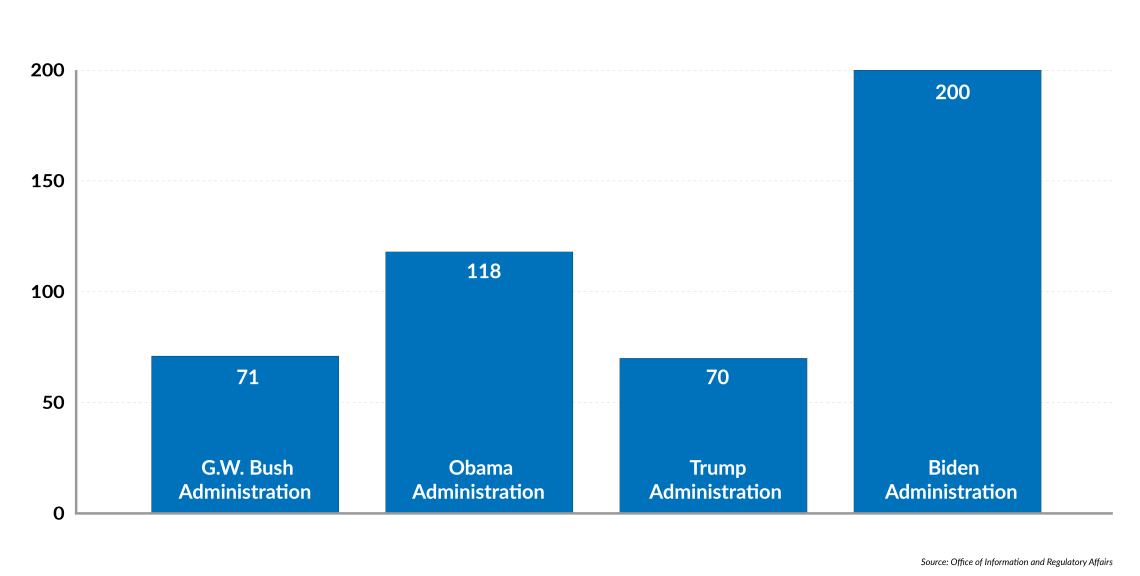Big government is back under Biden
New plans to raise taxes and increase spending could have significant economic and geopolitical consequences for the United States, writes Diane Katz.

In a nutshell
- The Biden agenda foresees a massive spending increase
- Excessive regulation will threaten economic recovery
- Washington’s influence abroad will be diminished
President Joe Biden has delivered his first State of the Union Address and, as directed by the United States Constitution, recommended to Congress “such Measures as he shall judge necessary and expedient.” Without exception, every one of them involves massive new spending and/or expansion of federal government power.
In other words, big government is roaring back.
In the hour-long speech on March 1, the president portrayed himself as a champion of workers, families and small businesses, pledging to foster well-paying jobs, reduce household expenses and nurture entrepreneurs. Strip away the sentimentality, however, and what remains is an agenda consisting of high taxes, profligate spending and excessive regulation.
The Biden administration’s regulatory output will continue apace despite the costly consequences.
These are the very policies that have contributed to the worst inflation in 40 years, an unprecedented labor shortage and supply-chain crisis, soaring rates of violent crime, and widespread discord and resentment. It is no wonder that Mr. Biden’s approval rating now hovers around 40 percent – a low point in his presidency.
The outbreak of Covid-19 and attendant lockdown obviously contributed to the U.S.’s economic and social distress. But the more fundamental problem is the American left’s misplaced faith in the government’s ability to remedy every affliction and right every wrong – the very conceit permeating the Biden blueprint.
The administration appears to be oblivious (or indifferent) to the fact that unconstrained spending and regulation are incompatible with Washington’s capacity to counter Russian and Chinese aggression. But even if U.S. military readiness was unimpaired by budget cuts and political correctness, American influence abroad requires a robust economy.
The president’s regulatory plan for 2022 features even more constraints on conventional energy, while also proposing billions of dollars of additional taxpayer subsidies for wind and solar schemes that undermine grid reliability, encumber economic growth, and strain household budgets.
Nor can the U.S. counter China’s geopolitical muscle by restricting oil and gas companies’ access to credit, as advocated by Sarah Bloom Raskin, formerly the president’s nominee for the Federal Reserve’s Vice Chair for Supervision.
Regulatory deluge
The (literal) Biden agenda for 2022 lists 2,678 “active” regulatory actions, which exceeds by 35 percent the number of prospective rulemakings by the Trump administration in the same period in office. The volume of new rules rivals the regulatory excesses of the Obama years, when the private-sector regulatory burden increased by $122 billion annually.
Some 200 of the active rulemakings are designated as “economically significant” – that is, regulations that are each expected to have an annual effect on the economy of $100 million or more. These include yet another round of emissions restrictions for passenger vehicles and light-duty trucks, which the Environmental Protection Agency acknowledges will add $1,000 to the price of a 2026-model vehicle. (But that lowball estimate fails to account for all the highway injuries and fatalities that will result from vehicle downsizing.)
The administration is also planning to reverse a long-standing policy that fiduciaries of employee pension plans may not sacrifice investment returns or assume greater risks to promote social policy goals. Doing so would elevate political ideology over financial performance, undermining investment.
Facts & figures
Economically significant rulemakings

The most widely cited estimate pegs the annual cost of regulatory compliance to be $2 trillion, which roughly equals the amount of individual and corporate taxes collected by the federal government. Just the paperwork burden of federal red tape alone exceeds 10.6 billion hours annually, at an estimated cost of $145.2 billion.
Another measure of the unbridled regulatory output: the Code of Federal Regulations has increased in volume by 35 percent since 2000, and 239 percent during the past five decades (from 54,834 pages to 185,984 pages). The complexity of the federal regulatory and tax codes presents an enormous hurdle for small business start-ups and a major advantage for incumbent corporations.
It is no surprise that the U.S. has dropped to 25 in the Heritage Foundation’s newly released Index of Economic Freedom. According to the authors, the U.S. decline “has been driven by [a] deteriorating fiscal condition and exacerbated by ongoing record inflation … [and] is serious cause for alarm, as it has real and tangible consequences for American consumers and producers.”
From day one, the Biden administration has targeted for repeal virtually all the regulatory restraints instituted by President Donald Trump, who substantially reduced the volume of new regulation. According to a tracker maintained by the Brookings Center on Regulation and Markets, President Biden has revoked 44 of Mr. Trump’s executive orders, including a directive to agencies to eliminate at least two prior regulations for every new regulation issued, and a budgetary cap on regulatory costs.
In place of the Trump reforms, the White House is easing rulemaking standards, including requirements on cost-benefit analysis. The president boasts of conferring upon regulators the “flexibility” to undertake “robust regulatory action.” That is the worst course possible at any time – but particularly now, when regulatory escalation will inhibit the nation’s economic recovery from the Covid-19 lockdown.
The White House is also weaponizing antitrust policy to flaunt its populist credentials. President Biden’s appointment of antitrust activist Lina Khan to head the Federal Trade Commission recalls the trust-busting fervor of the Progressive Era. But many of the administration’s claims about the state of competition in the U.S. economy either lack credibility or are outright false.
The regulatory frenzy underway contradicts the president’s oft-repeated pledge to institute an “ambitious whole-of-government equity agenda.” While a burden for all, overregulation harms low-income families and fixed-income seniors the most; the costs translate to higher consumer prices that exhaust a relatively larger share of their household budgets.
Massive spending
In conjunction with the Democrat-controlled Congress, President Biden added nearly $7 trillion to the national debt in his first year in office, according to the Congressional Budget Office. Still in the works are hundreds of billions of dollars in new corporate giveaways masquerading as a counteroffensive to the China threat. Instead of eliminating government obstacles to American innovation and investment, the measures now pending in Congress would shower additional subsidies on special interests, including labor unions and the green lobby.
Ever more constraints on economic freedom weaken the most reliable bulwark against tyranny.
The infusion of cash (which also includes more than $3 trillion in Covid relief during the Trump administration) is a major factor in the worst inflation in decades – currently running at 7.5 percent. Nevertheless, the president used his State of the Union Address to lambast profit-taking as the culprit, admonishing businesses to “lower your costs, not your wages.”
Writing in the Wall Street Journal, former Senators Phil Gramm and Mike Solon likened the administration’s agenda to “the Chinese Communist Party’s latest five-year plan.” But the U.S. cannot “outcompete” China or check its geopolitical influence by hindering American business formation and expansion, raising energy costs, suppressing employment with overgenerous welfare payments, or otherwise promoting government power rather than economic power. Ever more constraints on economic freedom weaken the most reliable bulwark against tyranny.
Scenarios
The Biden administration’s regulatory output will continue apace despite the costly consequences. Members of Congress – Democrats and Republicans alike – are notorious for evading accountability by delegating regulatory power to federal agencies. The regulatory leviathan resists reform because it is a political spoils system by which bureaucrats impose their will, and special interests profit.
Record inflation is generating unease among (some) Democrats who face reelection in November, thus diminishing lawmakers’ eagerness for unbridled spending. (That said, the radical left wing of the party continues to exercise inordinate power.) The president’s $2.2 trillion “Build Back Better” bill faces a steep climb in the Senate, where moderate Democrats are demanding a modicum of restraint.
Republicans are hoping to capitalize on the president’s dismal approval rating to overcome the Democrats’ control of the Senate and slim majority in the House. Russia’s invasion of Ukraine strengthens their potential given long-standing voter confidence in the Republicans’ handling of foreign policy compared to the Democrats.








